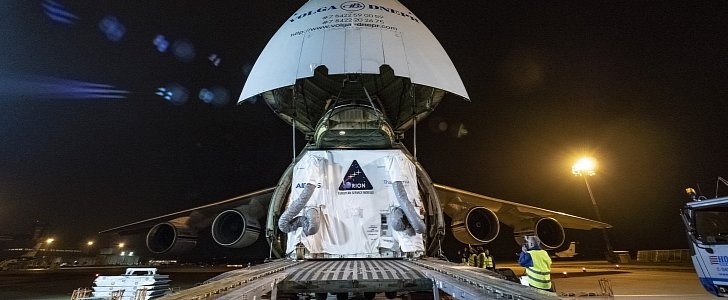The assembly of NASA’s own spacecraft, the Orion, is entering its final leg after the American space agency received delivery on Tuesday of the European Service Module.
This pompous name is used by NASA and its European counterpart ESA to describe the part of the ship that will handle in-space maneuvering throughout the mission.
The unit includes the main engine of the ship, a repurposed shuttle unit named Orbital Maneuvering System, 24 smaller engines grouped into six pods to provide attitude control and eight thrusters used for orbit corrections.
The hardware comprises in all 20,000 components including four solar array wings, and tanks for gas and propellant.
Now that this module is stateside, NASA engineers will begin testing it to ensure all is in working order. After this stage is complete, the operations for pairing it with the crew module will begin. The resulting assembly, expected to be completed early next year, will then be sent to the Plum Brook Station in Ohio.
There, it will spend 60 days inside the world’s largest thermal vacuum chamber. If all goes well, the Orion will then come back to the Kennedy Space Center for integration with the Space Launch System that will carry it into space.
The first flight of the Orion, Exploration Mission-1 (EM-1), will be an uncrewed test that will see the spacecraft traveling 280,000 miles from Earth (450,000 km), well past our Moon, on a three-week-long journey.
NASA says during this flight the Orion “will stay in space longer than any ship for astronauts has done without docking to a space station and return home faster and hotter than ever before.”
Following EM-1 will be Exploration Mission 2 (EM-2), which will see a crewed flight get to orbit, do a highly elliptical demonstration run around the world and then, boosted by the European Service Module, head for the Moon, without landing there. The mission is expected to last for a minimum of eight days.
The European Service module is the result of a collaboration between several large companies from ten European states, including ESA’s longtime partner and contractor Airbus, while the crew module for the Orion has been built by Lockheed Martin.
The unit includes the main engine of the ship, a repurposed shuttle unit named Orbital Maneuvering System, 24 smaller engines grouped into six pods to provide attitude control and eight thrusters used for orbit corrections.
The hardware comprises in all 20,000 components including four solar array wings, and tanks for gas and propellant.
Now that this module is stateside, NASA engineers will begin testing it to ensure all is in working order. After this stage is complete, the operations for pairing it with the crew module will begin. The resulting assembly, expected to be completed early next year, will then be sent to the Plum Brook Station in Ohio.
There, it will spend 60 days inside the world’s largest thermal vacuum chamber. If all goes well, the Orion will then come back to the Kennedy Space Center for integration with the Space Launch System that will carry it into space.
The first flight of the Orion, Exploration Mission-1 (EM-1), will be an uncrewed test that will see the spacecraft traveling 280,000 miles from Earth (450,000 km), well past our Moon, on a three-week-long journey.
NASA says during this flight the Orion “will stay in space longer than any ship for astronauts has done without docking to a space station and return home faster and hotter than ever before.”
Following EM-1 will be Exploration Mission 2 (EM-2), which will see a crewed flight get to orbit, do a highly elliptical demonstration run around the world and then, boosted by the European Service Module, head for the Moon, without landing there. The mission is expected to last for a minimum of eight days.
The European Service module is the result of a collaboration between several large companies from ten European states, including ESA’s longtime partner and contractor Airbus, while the crew module for the Orion has been built by Lockheed Martin.

